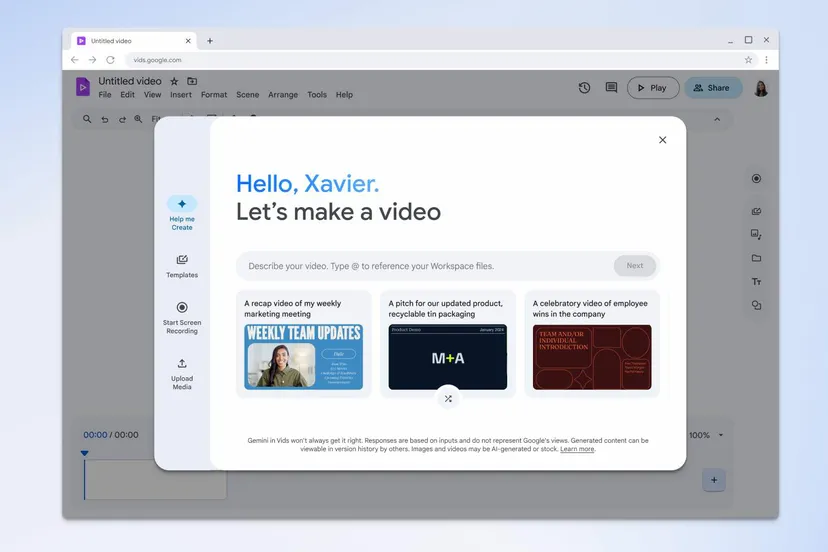
For decades, work has revolved around documents, spreadsheets, and slide decks. Word, Excel, PowerPoint; Pages, Numbers, Keynote; Docs, Sheets, Slides. Now Google is proposing to add another to that triumvirate: an app called Vids that aims to help companies and consumers make collaborative, shareable video more easily than ever.
Google Vids is very much not an app for making beautiful movies… or even not-that-beautiful movies. It’s meant more for the sorts of things people do at work: make a pitch, update the team, explain a complicated concept. The main goal is to make everything as easy as possible, says Kristina Behr, Google’s VP of product management for the Workspace collaboration apps. “The ethos that we have is, if you can make a slide, you can make a video in Vids,” she says. “No video production is required.”
Based on what I’ve seen of Vids so far, it appears to be roughly what you’d get if you transformed Google Slides into a video app. You collect assets from Drive and elsewhere and assemble them in order — but unlike the column of slides in the Slides sidebar, you’re putting together a left-to-right timeline for a video. Then, you can add voiceover or film yourself and edit it all into a finished video. A lot of those finished videos, I suspect, will look like recorded PowerPoint presentations or Meet calls or those now-ubiquitous training videos where a person talks to you from a small circle in the bottom corner while graphics play on the screen. There will be lots of clip art-heavy product promos, I’m sure. But in theory, you can make almost anything in Vids.
You can either do all this by yourself or prompt Google’s Gemini AI to make a first draft of the video for you. Gemini can build a storyboard; it can write a script; it can read your script aloud with text-to-speech; it can create images for you to use in the video. The app has a library of stock video and audio that users can add to their own Vids, too.
Once you’ve made something in Vids, you can share it with others. But like Google’s other productivity tools, when you share a Vid (that’s what Google wants you to call them), you’re not just sharing a file with a play button. People you share with can comment, leave notes, and even edit the video themselves. “You can export it to an MP4 if you wanted,” Behr says, “but what we hope is that it looks a lot like our other collaboration apps.” In her mind — and Google’s — a video isn’t that different from a spreadsheet.
There are lots of tools aiming to make things like this easier, from video-messaging tools like Loom to editing suites like Descript. Companies like ClickUp are starting to bake video features right into their productivity suite, too. Even Vimeo has become in large part a business-focused tool for making quick marketing videos. Google’s actually late to this market, but it’s making the same bet as everyone else: that in an era of remote work and a culture dominated by video, employees are going to spend less of their 9-5 writing emails and more of it making videos.
Google’s big advantage here is that it’s Google and can integrate Vids with its many other tools. There’s lots of that coming, Behr says, along with mobile support over time. One thing missing, though? Any sign of YouTube. You know, that other video service Google owns. Behr laughs when I mention it and says that there’s some tech shared between the products but that “the audience and use cases are pretty fundamentally different” between the two products. This is a work product, for workers, to use at work. “We’re trying to make sure we’re really supporting that use case, you know?”
Google plans to launch Vids in a public beta this summer. Some Workspace customers have been testing it already, and Behr says she’s already seeing some trends emerge. Most Vids are short, she says — under three minutes. Most are things like pitches, training videos, updates, and videos celebrating accomplishments or people. Behr says she has replaced her weekly recap emails with Vids, “and I get a lot of feedback that people like it because they can see my facial expressions when I’m talking about things.”
Vids could have been a feature in Slides or Docs. By breaking it out on its own, Google seems to want to signal that this is something more than just another way to present a deck; it’s an entirely new way to share information. I’m not sure you can trust any Google product to stick around forever, but the Docs, Sheets, and Slides gang is as sticky as anything in tech. Google thinks Vids is just as big.
























